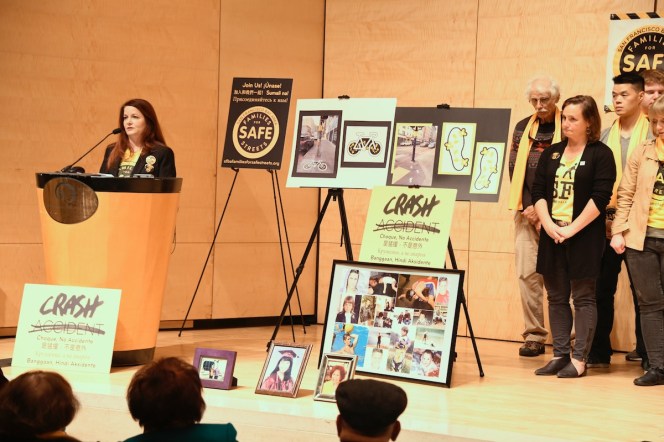Note: GJEL Accident Attorneys regularly sponsors coverage on Streetsblog San Francisco and Streetsblog California. Unless noted in the story, GJEL Accident Attorneys is not consulted for the content or editorial direction of the sponsored content.
Forced indoors because of the Bay Area's smoky conditions, families of traffic crash victims assembled at the Koret Auditorium of the San Francisco Public Library on Sunday for the annual World Day of Remembrance for Road Traffic Victims.
"In the spring of this year, a close friend of mine, Candi Duazo, succumbed to a crash at the intersection of Ocean Avenue and Victoria Street in the Ingleside District," said Estelle Oloresisimo, President of the Fil-Am Friendship Network, and one of the speakers at the events. "She was an active community leader who donated generously to causes that make a difference in people’s lives."
Oloresisimo pointed out that Duazo was 80 years old. "Based on public statistics, senior citizens are four times more likely than people under 65 to be killed in traffic crashes. This problem is getting worse every day and this is not just in the United States… it’s happening around the world," she said.
"When we first started planning today’s event, we didn’t expect to hold it indoors," said Cathy DeLuca, Walk SF Policy and Program Director, referring to the smoky conditions that compelled them to cancel what is normally a walking event. "Unfortunately, what we can anticipate are deaths and serious injuries caused by traffic crashes. Every year in the United States, 40,000 people are killed in traffic crashes."
She also pointed out that millions more sustain life-altering injuries. Speakers at the event also stressed that the deaths and injuries are not "accidents"--they are the inevitable outcome of deadly street designs, speeding and other irresponsible driver behaviors, and a lack of traffic enforcement.
“My son’s death was no accident and it’s a slap in the face calling it that, because it implies that there was no way to prevent it. His death was completely preventable, if the driver had only taken an extra second to look before making that turn or if the streets were designed for bike safety,” said Julie Mitchell, a founding member of San Francisco Bay Area Families for Safe Streets, seen speaking in the lead image. “Let’s stop calling them accidents and start calling them what they really are--preventable crashes.” Mitchell’s son Dylan was killed in 2013 while biking at South Van Ness Avenue and 16th Street. He was 21 years old.
San Francisco appeared to make significant progress in reducing fatal crashes in San Francisco in 2017. But the city backslid a bit this year, with 19 fatalities in San Francisco as of October--two more than in 2017, when 17 people were killed.
Meanwhile, San Francisco only has five years left to meet its Vision Zero goal of zero severe and fatal traffic crashes by 2024.
"4.5 million people were injured seriously enough to require medical attention. That is just in our country. If we had that many deaths and injuries from any other transportation vehicle--buses, airplanes--there would be an outcry. Well, this is our outcry," said DeLuca.






